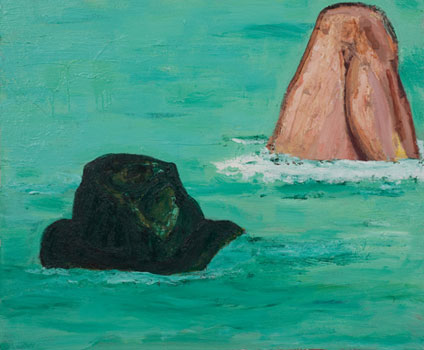
Continuing through December 24, 2011
Encrusted with thick pigment, these small paintings by Martin Lubner are the dangling participles of the artist’s long career as an expressionist. The colors are odd and individualistic, the drawing deliberately de-skilled. The pigment crawls out towards and beyond the edges, as though the painter’s mind was reaching out and searching for forgotten memories. The art reflects the mind of an adult probing the depths of memory and finding childhood or its primal layers. Each work seems like a seascape where memories travel unmoored, as signified by the arbitrary objects that float on an unbroken ocean. What the painter remembers are the objects of his childhood - like paraphernalia on the “Paint Table,” the paintbrush in “Blur” - as well as the art of others. “Paint Table” contains not just a catalogue of reminiscing - a baseball bat once lofted, an apple once tasted, a pair of breasts once touched - but a Shakespearian catalogue of the ages of “man” or a person slouching towards time’s sunset.
“Impossible Forms” provides a hint of Lubner’s thought process. In the background, a black profile of a ship’s bow is sinking beneath the waves of a purple sea, an uneven, jagged horizon line. Beneath the blood-red light of a Monet sunset, unidentified objects jostle across the surface, like lifeboats from the Titanic. In addition to the sinking vessel, the unfathomable forms symbolize what the artist calls “the unthought known.” This evocative term comes from psychologist Christopher Bollas, who coined the phrase in reference to the way in which the mind learns on such a deep and primal level that it never has to think of its “knowns.” The forms are “impossible” because they are “unthought” but available in that fluid space that is remembering.
Another source of intellectual inspiration for Lubner is Antonio Damasio’s “Self Comes to Mind: Constructing the Conscious Mind.” Damasio refers to what he calls the “Proustian effect in memory, the reason why we often recall the contexts rather than just isolated things.” Lubner’s sea is the context and the objects are Proust’s Madeleines. “Float” is not just a simple raft at rest; it is the raft of Gericault, languishing in Monet’s pond at Giverney, resting on the lily pads … or is it? The lilies are black and the raft is built in a useless “L” shape and bound by only one rope. While cryptically asking “does the raft consider Gericault?,” the artist refers to the “tsunami” of life, the daily life that rolls like the sea, washing up past events while some memories sink to the bottom of the mind. Other souvenirs are suspended, waiting to be reawakened. Proust wrote of “this unremembered state of thought” that “reappeared” when he drank the tea and ate the “plump little cake.”
In “Cover,” the artist paints a man’s black fedora, Man Ray’s mediation of female genitalia, sailing past an object we all know existed but was unpainted by Jacques-Louis David: Marat’s knee. This is a strange knee, bent as though the bathtub was too small or as if contracted in the death throes of the revolutionary.
Lubner’s term “flotsam” is part of a trilogy, one term in the phrase “flotsam, jetsam and lagan,” dating back to the 17th century. These are nautical terms, referring to the fate of objects lost at sea. “Flotsam,” the subject of Lubner’s paintings, are those random objects that are without origin, carried here and there by rolling waves; “jetsam” are those things deliberately thrown overboard and are seen bobbing in the wake of a ship, and “lagan” is that which sinks to the bottom of the sea, recovered only at great cost. The artist does not paint “lagan,” which cannot be seen; “jetsam” is uninteresting to him because these discards are deliberate. The key idea for Lubner’s paintings is “flotsam,” which belongs to no one and everyone.
Published courtesy of ArtSceneCal ©2011
